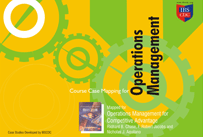Popular Searches
Useful Links
Operations and Project Management Case Study
Case Title:
Reliance Communications: The Technology Dilemma
Publication Year : 2006
Authors: Rajnikant, Doris John
Industry: Not Applicable
Region:India
Case Code: OPM0018C
Teaching Note: Available
Structured Assignment: Not Available
Abstract:
It was the year 2006- boom time in the Indian Mobile Industry. Sales were on the rise and operators had been bombarding the public with promotional offers and value added services in order to increase their subscriber base. Though India had a huge number of subscribers, it generated the lowest revenue in the world due to the poverty of masses, high levels of industry specific taxes and inadequate margins due to high levels of competition. The service providers operated using GSM or CDMA technology.
Till 2003, a typical upper middle class household had an annual income of $10,000 to $13,000 and acquiring a GSM handset required $60 while CDMA handsets required about $80 and at times more. In spite of the low income levels, technology was an important criterion for Indians. One in ten Indians had access to safe drinking water but one in three had a color television and one in seven had a cable television.
To generate revenues in such a market, mobile operators had to concentrate on the upper segment of the society and charge a premium pricing. This was the case until the entry of Reliance, India’s largest business house, into the mobile industry in 2003. Reliance entered the mobile market in a massive way through its subsidiary known as Infocomm and targeted the mass market by adopting cost leadership strategy. Though it faced a lot of teething problems in the initial stages, it was able to overcome them all and achieve the second position in the Indian mobile market within a short span of time. The success formula of Infocomm helped by changes in government policy enabled Infocomm’s competitors to adopt a business model similar to that of Infocomm. The higher average revenue per user (ARPU) and economies of scale of GSM technology also enabled the GSM competitors to realise a much higher profit than Infocomm, thus acting as a serious threat to it. Due to this, the parent company of Infocomm planned to enter the GSM segment as well. But it faced government restrictions which would limit its operations. It would also have to incur handset switching costs and infrastructure costs. This left the company in a dilemma about the shift.
The case briefly examines the cost reduction strategies adopted by Infocomm. It also discusses the strategic changes and the feasibility of its GSM venture.
Pedagogical Objectives:
- Cost leadership strategy used by Infocomm
- Various strategic changes adopted by Infocomm and the technological dilemma- GSM vs CDMA.
Keywords : Technology dilemma; Reliance Communications; 3G GSM; CDMA; Infocomm; Operating Strategies Case Study; Cost leadership strategy; India mobile market; Telecom industry; Entry strategy; Average revenue per user (ARPU); Ambani; Co-branding; Mobile application; Market share of mobile subscribers; Cellular tariffs
Contents:
- Indian Mobile Market
- Entry Strategies of Infocomm
- Innovations in Sales & Marketing
- Problem Phase
- GSM- To Shift or Not To Shift?
Related Case Studies
- »Safeway Inc: Is it on a Safer Way?
- »Efficient Project Management at TransWorks Information Services Pvt. Ltd., an Indian-based BPO Company
- »The Evolution of the Toyota Production System
- »Pantaloon Retail India: Creating Successful Formats
- »BAA’s T5: Novel Project Management
- View all Operations and Project Management case studies »
Case Studies on Reliance
Recently Bought Case Studies

 Global Banking Industry: The New Horizons
Global Banking Industry: The New Horizons
Price: $25
Hardcover edition
ISBN 978-81-314-2414-8 Fast Food Retailing Industry - Vol. I
Fast Food Retailing Industry - Vol. I
Price: $25
Hardcover edition
ISBN 978-81-314-2456-8 Decision Making
Decision Making
Price: $50
Hardcover edition
ISBN 978-81-314-1571-9- View all Casebooks »
Case Studies On
 Course Case Mapping For Operations Management
Course Case Mapping For Operations Management
Price: $Course Case Mapping For Operations Management
Hardcover edition Course Case Mapping For Quantitative Methods
Course Case Mapping For Quantitative Methods
Price: $Course Case Mapping For Quantitative Methods
Hardcover edition Course Case Mapping For Business Research Methods
Course Case Mapping For Business Research Methods
Price: $Course Case Mapping For Business Research Methods
Hardcover edition- View All Course Casemaps»
Course Case Mapping For
 An Interview with Personnel of Vaatsalya Group
An Interview with Personnel of Vaatsalya Group
Price: $Vaatsalya Hospitals (B): The Operational Model An interview with Dr. Ashwin Naik & Dr. Veerendra Hiremath
An interview with Dr. Ashwin Naik & Dr. Veerendra Hiremath
Price: $Vaatsalya Hospitals (A): The Business Model An Interview with Dr.Rajiv Malhotra & (Prof)Dr.M.P.Sharma
An Interview with Dr.Rajiv Malhotra & (Prof)Dr.M.P.Sharma
Price: $Managing a World-Class Hospital: The Rockland Story- View all Video Interviews»
Video Interviews
 Training and Development
Training and Development
Executive Brief with Anjali Mukherjee
Highly Recommended for Human Resource Management / Training and Development Course You Can't Play by Rules, Always
You Can't Play by Rules, Always
Executive Brief with R.D. Prasad, Product Manager.
Highly Recommended for Organizational Behavior Course New Recruit MBAs Attitudes
New Recruit MBAs Attitudes
Executive Brief with Lopamudra Ray, Keya Gupta and Deepika Lingala.
Highly Recommended for Organizational Behavior Course- View all Executive Briefs»
Executive Brief
 David Conklin
David Conklin
David Conklin, is a professor at the Richard Ivey School of Business
Speaks on Government and Business Lord Meghnad Desai
Lord Meghnad Desai
Lord Meghnad Desai, is an Indian-born British economist and Labor politician
Speaks on Government and Business Vijay Govindarajan
Vijay Govindarajan
Vijay Govindarajan, is widely regarded as one of the world’s leading experts on strategy and innovation
Speaks on Reverse Innovation- View All Executive Interviews»

